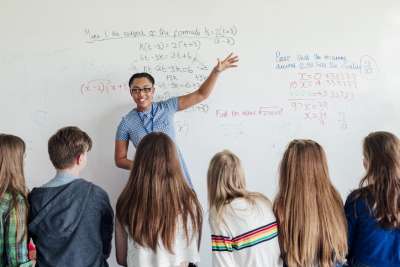Learn how to effectively use fraction strips, spinners, counters, and more
Manipulatives are physical objects that are used as teaching tools to engage students in the hands-on learning of mathematics. They can be used to introduce, practice, or remediate a concept. Use this resource to help your students learn how to use manipulatives successfully.Looking for more manipulatives like fraction strips? Find them in our math resources center.
Assessment
Students' representations often provide an insight into their mathematical thinking. Listen to how students describe their representations and the process they used, and analyze their reasoning to assess learning.
Remediation
Manipulatives can also be used in remediation. If a student is not performing well at one of the subsequent levels, pictorial or abstract, it may be helpful to go back to the concrete level to give more practice at this prerequisite level. This gives both you and the student an opportunity to correct any misconceptions that were carried into the other levels or to identify important knowledge that was not carried forward.
How Can You Stretch Students' Thinking?
Help students extend the knowledge they are building, using manipulatives, to a subsequent or lateral math topic.
For example, if students are using place-value blocks to subtract, help them extend what they are learning about regrouping to subtracting with larger numbers. For example, if students are solving the problem 43 - 16, they know they can regroup one of the four ten-sticks to 10 ones, so 43 is represented by 3 ten-sticks and 13 ones-blocks. Discuss with students how they might use that information to find the answer to the problem 430 - 160.
If students are using tiles to build various rectangles to explore area and perimeter, extend their thinking to square numbers by challenging them to find which numbers of tiles can be used to build squares. For example, the area of the shape on the right is 6 tiles, and the area of the shape on the left is 9 tiles. Have students create shapes and determine what is the same about all of the square shapes they create.
When Can You Use It?
Manipulatives can be used to teach basic number operations, geometry, probability, measurement, or algebra. Students can draw a picture of how they used manipulatives to solve a problem, or create their own word problems and model them. Older students can write about how they solved a math problem. If they are using manipulatives to solve 4.5 + 235.6, students can write about the step-by-step process they used to solve the problem. Using manipulatives is also a science strategy: when students grow seeds, use wires and batteries to light bulbs, or mix solutions to determine whether liquids are acids or bases, they are involved at the hands-on, or concrete, level of building understanding. The activities and experiments can help students lay the foundation of understanding scientific concepts and processes.
The following are some examples how to use manipulatives:
Have students show three blue counters, and then match each blue counter with a red counter.
Create a sentence such as, "__ students were playing kickball and __ students were on the swings. There were __ students all together." Have students take turns changing the numbers, and model each sentence using manipulatives.
Show five red counters and four blue counters. Then ask, "Are there more red or blue counters?"
Have students use 2-sided counters to show 3 (white) + 6 (black). Then ask, "How many more black counters are there?
Have students sort money into pennies, nickels, dimes, and quarters. How many pennies are heads up? How many nickels?
Have students show these math problems using manipulatives. Jack collected 66 baseball cards this month. If he collects the same amount each month, how many will he have in 6 months? 66 x 6 = 396
Sue has 10 markers. She has 2 friends. Show how many markers each friend will get.
Sue has 10 markers. She wants each friend to get 2 markers. Show how many friends can get markers.
There are 245 students in the second grade. If they are divided into two groups to watch a play, how many students will be in each group? 245 divided by 2 = 122 R1. There will be 122 students in one group and 123 students in the other group.
Four t-shirts are on sale for $6.00. How much does each one cost? 600 divided by 4 = 150. Each shirt is $1.50.
Find fractions that are equivalent to 1. Equivalent fractions: 4/4, 2/2, 8/8
Add 1/4 + 3/6. Find the common denominator and then add. The common denominator for 4 and 6 is 12. Change 1/4 to equivalent fraction 3/12. Change 3/6 to equivalent fraction 6/12. The answer is 9/12. Change to equivalent fraction 3/4. Alternate: Change 3/6 to equivalent fraction 1/2. The common denominator for 4 and 2 is 4. Change 1/2 to 2/4, and add to find 3/4.
Lesson Plans
Comparative Subtraction
In this primary lesson, students use two-sided counters to solve subtraction problems.
Odd and Even Numbers
In this primary lesson, students use two-sided counters and a hundreds chart to show and then extend the alternating pattern of odd and even numbers.
Ten More, Ten Less
This primary lesson uses base-10 manipulatives to identify the number that is one more or one less than a given two-digit number.













